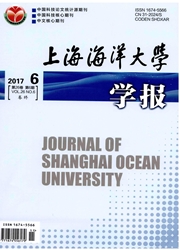

 中文摘要:
中文摘要:
为了提高坛紫菜叶状体的培养效果,在海水中分别添加2%、4%、6%、8%和10%的MES培养基,配出5种不同的培养液,并分别将其标记为1MES、2MES、3MES、4MES、5MES,然后分别用它们培养坛紫菜叶状体,结果显示:在培养的前两周,5个组的叶状体生长和湿重增加无明显差异,但两周后,各组叶状体的生长开始出现显著差异,其中2MES组和1MES组的生长速度快于其它3组。培养21d后,5个试验组的叶状体平均长度依次为2MES组〉1MES组〉5MES组〉3MES组〉4MES组;叶状体湿重增加依次为2MES组〉5MES组〉1MES组〉3MES组〉4MES组;叶状体的叶绿素a(Ch1.a)的含量在2MES中最高,1MES最低,其它组相差不大;藻红蛋白(PE)和藻蓝蛋白(PC)含量在2MES中比3MES中略低,但高于其它组。上述结果表明,在海水中添加4%的MES培养基对坛紫菜叶状体的生长是最适宜的,这一结果对以往文献中报道的使用MES培养基时一般只在海水中添加2%的浓度将是一个有益的修正。
 英文摘要:
英文摘要:
The gametophytic blades of Porphyra haitanensis were cultured in five different culture solutions named 1MES,2MES,3MES,4MES and 5MES, which were composed of seawater and MES medium in volume proportions of 2%, 4%, 6%, 8% and 10%, respectively. In the first two weeks of culture, no obvious differences of growth and increase of fresh weight of the blades were found among the five culture groups. However, significant differences of blade growth appeared after two weeks of culture, showing the growth rates in 2MES and 1MES groups were faster than other three groups. After being cultured for 21days, the average length of the blades in the five culture groups was: 2MES 〉 1MES 〉 5MES 〉 3MES 〉 4MES and the average fresh weight was: 2MES 〉SMES 〉 1MES 〉3MES 〉4MES. The content of chlorophyll a (Ch1 . a) of the blades was highest in 2MES and lowest in 1MES group. There were no remarkable differences in the content of Chl. a in the blades between 3MES and 5MES. The contents of phycoerythrin (PE) and phycocyanin (PC) of the blades were a little lower in 2MES than in 3MES but higher than other groups. These results indicated that 2MES was the optimal solution for the culture of gametophytic blades in P. haitanensis.
 同期刊论文项目
同期刊论文项目
 同项目期刊论文
同项目期刊论文
 Genetic analysis of the position of meiosis in Porphyra haitanensis Chang et Zheng (Bangiales, Rhodo
Genetic analysis of the position of meiosis in Porphyra haitanensis Chang et Zheng (Bangiales, Rhodo 期刊信息
期刊信息
